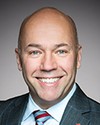Here's the thing. We had a horrific suicide crisis in Attawapiskat in March or April. At the same time there were six states of emergency declared across Canada in communities that were completely overwhelmed and could not deal with the self-destructive behaviour of their youth. Yet every time it happens, it seems to me that at the government level there's shock; there's surprise. They tweet out that it's a tragedy.
To me, a tragedy is someone getting hit by a car while they're walking home. Something that's predictable, something that's preventable is not a tragedy to me. That's something else; it's a form of negligence.
I mention that because I was in Saskatchewan talking to people about the latest suicide crisis, and we were getting the same level of response—the shock, the surprise. Now we're going to send in an emergency team and we might have them for 30 days.
I was talking to front-line workers who had been doing the programming of suicide prevention. They are not working up in La Ronge because their funding is gone. They get hired on these short-term projects.
I look at the projects funded by the Aboriginal Healing Foundation, and I see the dramatic drop-off from 2009 down to 2012. From that point on, in my region we had 700-plus suicide attempts, and nothing was done.
I'd like to ask you about this idea of sending in an emergency team. The minister, God love her, sent out a tweet the other night, saying, “Hey kids, there's a 24-hour hotline,” as opposed to supporting the people who could actually do the preventative work.
Do you see that there's a connection between these suicide clusters and suicide effects, and the fact that there is no proactive programming in many of the high-risk regions where we could have predicted this would happen?



